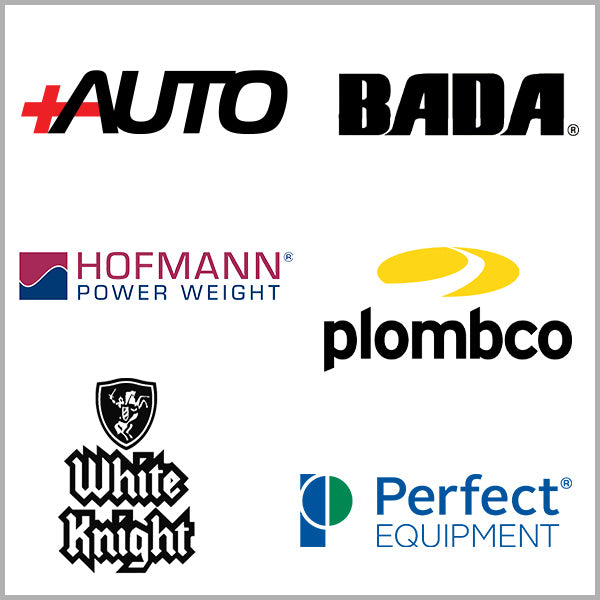
Guide - Tape Weights
Adhesive tape wheel weights have emerged as a popular alternative to traditional balancing methods for passenger cars and trucks, offering a sleek and versatile solution for modern wheel designs.

Brands - Only the Best!
Wheel Weight Warehouse carries the top brands like +Auto, Bada, Perfect Equipment, Plombco, Hofmann, and White Knight. Find the right style of weight for your needs right here!
Style - Tape Weights
Low Profile: A lower height decreases visibility without compromising the wheel's apperance
Contoured: A slight contour in shape will provide maximum contact patch to the wheel
Finishes: Black and various shades of Silver will match different types of wheels
Increments - Tape Weights
1/4 oz: Individual segments of 1/4oz weight for precise measurements
1/2 oz: Individual segments of 1/2oz weight for detailed measurements
1 oz: Individual segments of 1 oz weight for less cluttered appearance
•
Benefits - Tape Weights
1. Aesthetic Appeal: Unlike clip-on weights, adhesive weights are attached to the inner surface of the wheel, keeping them hidden from view. This preserves the visual appeal of alloy wheels, making them ideal for custom or high-end rims where appearance matters.
2. Versatility with Wheel Types: They adhere to a variety of rim surfaces, including alloy, chrome, and painted wheels, without requiring a flange for attachment. This flexibility makes them suitable for modern wheel designs that may not accommodate clip-on weights.
3. Reduced Risk of Wheel Damage: Since they don’t clip onto the rim’s edge, adhesive weights avoid scratching or denting delicate finishes, a common concern with clip-on weights on alloy wheels. This helps maintain the wheel’s integrity and resale value.
4. Ease of Installation: Adhesive weights are simple to apply—clean the surface, peel the backing, and press into place. They don’t require specialized hammers or crimping tools, making them accessible for both professionals and DIYers with a tire balancer.
4. Precise Placement: The balancing machine pinpoints the exact spot for correction, and adhesive weights can be cut or segmented to fit precisely, ensuring accurate balancing with minimal waste. This precision reduces vibration effectively.
5. Corrosion Resistance: Many adhesive weights are made from steel or zinc with protective coatings, offering durability and resistance to rust compared to traditional lead weights, especially in harsh weather conditions.
6. Improved Ride Quality: By correcting imbalances, adhesive weights minimize vibrations, leading to a smoother ride, better handling, and reduced wear on suspension components—a critical benefit for both passenger vehicles and trucks.
7. Adaptability to Temperature Changes: High-quality adhesive tapes are designed to withstand extreme heat and cold, maintaining a secure bond over time, which is essential for trucks operating in diverse climates.
8. Cost-Effectiveness: While slightly more expensive than basic clip-on weights, their ease of use, compatibility with modern wheels, and lack of need for additional tools make them a practical investment for long-term tire maintenance.
These benefits make adhesive tape wheel weights particularly appealing for vehicles with alloy rims, truck fleets prioritizing efficiency, and owners seeking a balance of functionality and aesthetics. Their discreet application and reliable performance ensure they meet the demands of today’s diverse automotive landscape.
•
Installation - Tape Weights
1. Mount the Wheel on a Balancing Machine: Start by securing the tire and wheel assembly onto a tire balancing machine. The machine spins the wheel to identify imbalances, displaying the exact location and weight needed (in ounces or grams) to correct it.
2. Identify the Imbalance Location: Allow the balancer to complete its cycle. It will indicate where the weight should be placed—typically on the inner barrel or a flat surface of the wheel—and how much weight is required.
3. Select the Appropriate Weight: Choose an adhesive tape wheel weight that matches the balancer’s recommended size. These weights come in strips with segmented pieces and a strong adhesive backing. Cut or break off the necessary amount if using a strip.
4. Clean the Wheel Surface: Prepare the installation spot by cleaning the wheel’s inner surface where the weight will adhere. Use a specialized wheel cleaner to remove dirt, grease, and brake dust. Wipe the area thoroughly with a clean, lint-free cloth and let it dry completely to ensure maximum adhesion.
5. Position the Weight: Peel off the protective backing from the adhesive side of the weight, exposing the sticky surface. Carefully align the weight with the marked imbalance location on the wheel, holding it just above the surface to confirm placement before sticking it down.
6. Attach the Weight: Press the weight firmly onto the wheel surface with your fingers or a clean gloved hand. Apply steady, even pressure for 10-15 seconds to ensure a strong bond. For longer strips, start at one end and work toward the other to avoid air bubbles or misalignment.
7. Verify Adhesion: Gently press along the weight’s edges to confirm it’s fully adhered. It should feel secure and not lift when lightly tugged. If it doesn’t stick well, remove it with a plastic scraper, reclean the surface, and apply a new piece.
8. Re-Test the Balance: Return the wheel to the balancing machine and spin it again to verify the imbalance is corrected. The machine should indicate minimal or no residual imbalance. If adjustments are needed, carefully peel off the weight, reposition it, or add more as directed (though a fresh piece is preferred for optimal adhesion).
9. Final Inspection: Once balanced, remove the wheel from the machine and check that the weight is securely attached and flush with the surface. Ensure it’s positioned where it won’t interfere with brake components or tire beads when remounted on the vehicle.
•
Tips - Tape Weights
- Work in a warm environment (above 50°F/10°C) if possible, as cold temperatures can weaken adhesive performance initially.
- Avoid touching the adhesive side with bare hands to prevent oil contamination.
- For trucks with larger wheels, ensure the adhesive weight is rated for heavier loads and wider surfaces.
- This method provides a clean, discreet balancing solution, ideal for modern wheels where aesthetics and surface protection are priorities. The process is slightly more prep-intensive than clip-on weights but delivers reliable results with the right technique.
